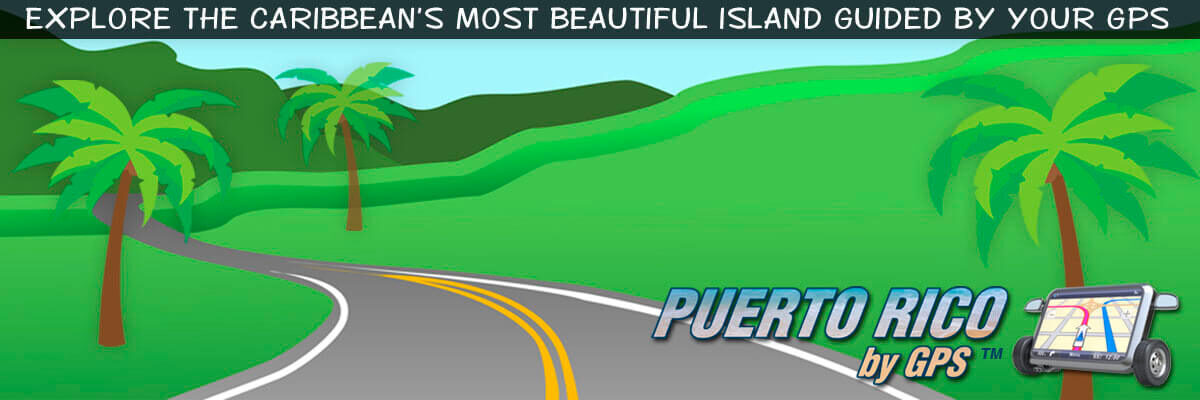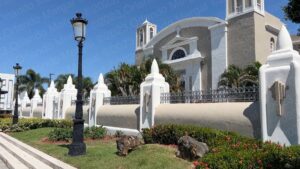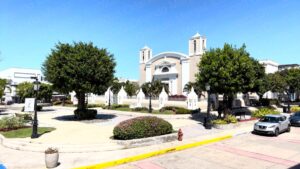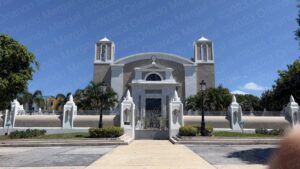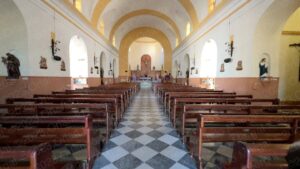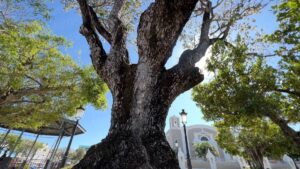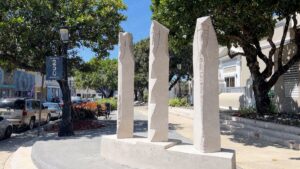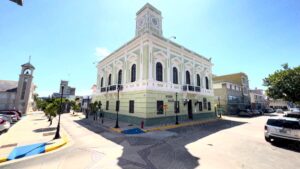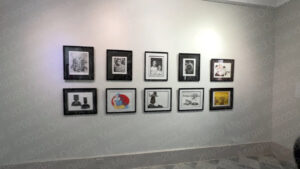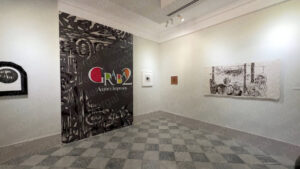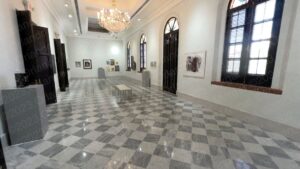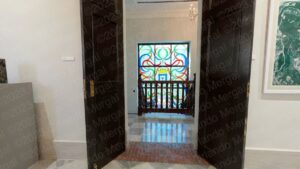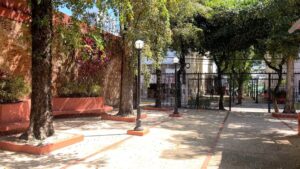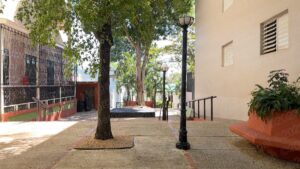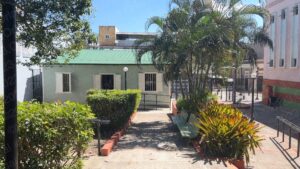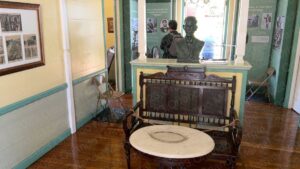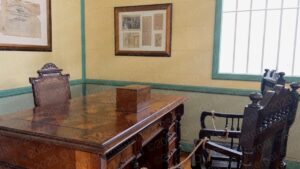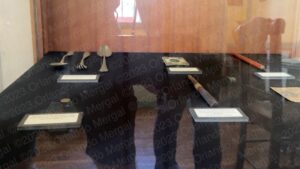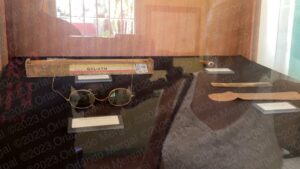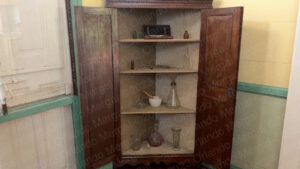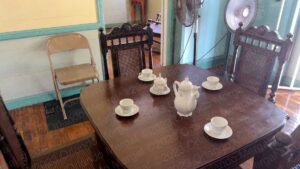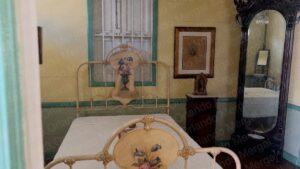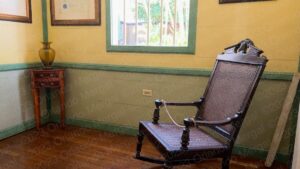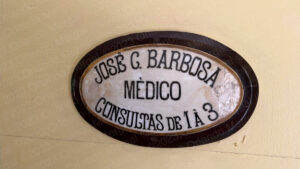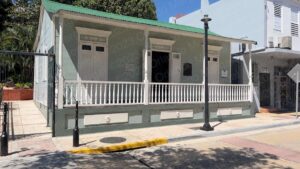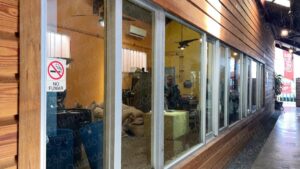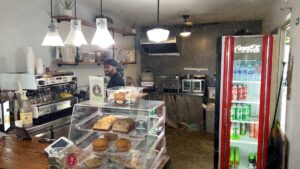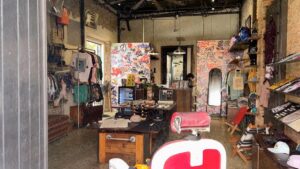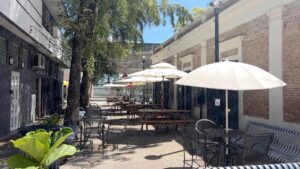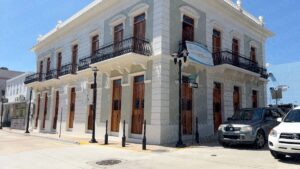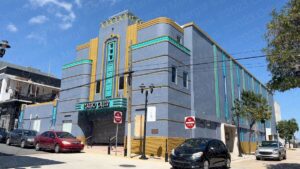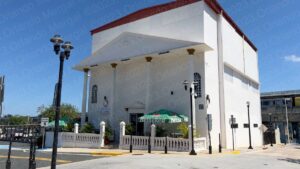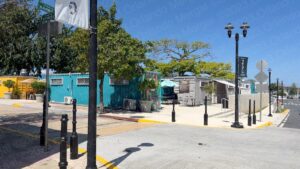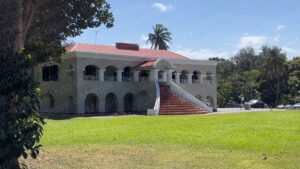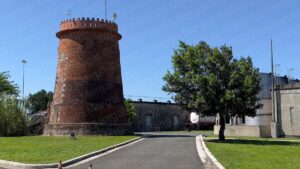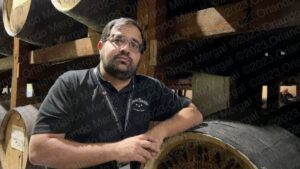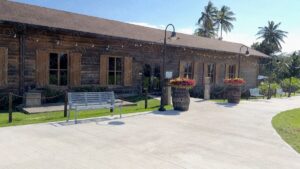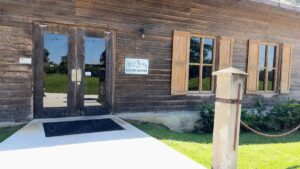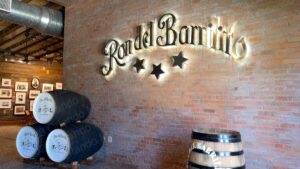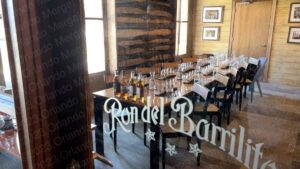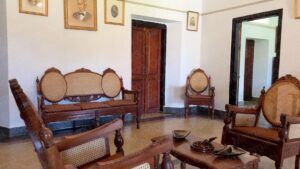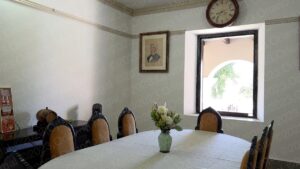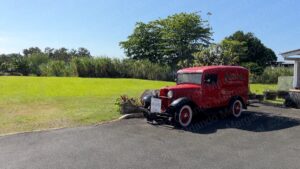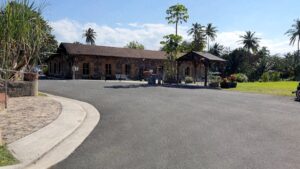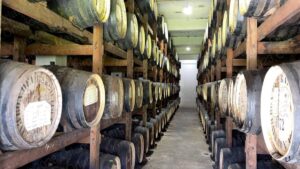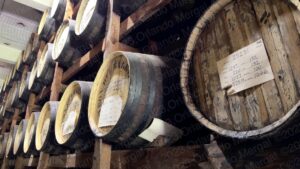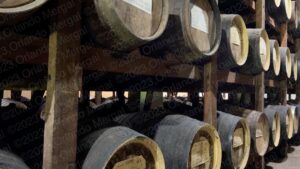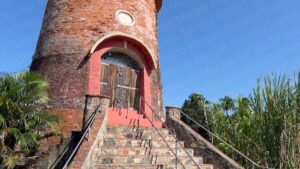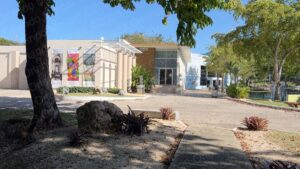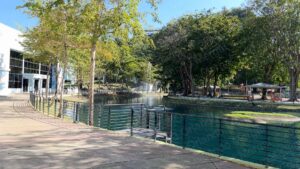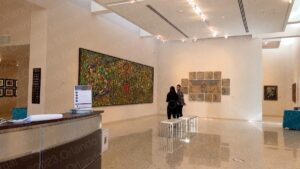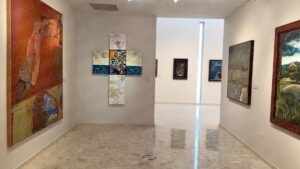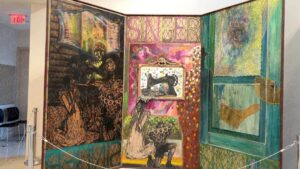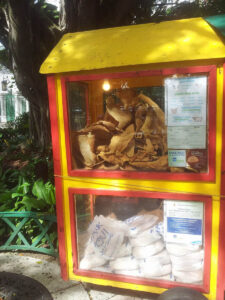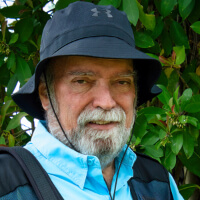It was the morning of February 28, 2023. The sky outside was so blue that it made your eyes hurt. And to top it all off, the temperature was a mild 78 degrees. It was the perfect day to go for a walk. So why not do it in a place that I hadn’t visited in 50 years; a place that’s only about 13 miles away from the tourist area?
Isn’t amazing how sometimes you have places right next to you and they simply remain ignored? It’s not that I hadn’t visited the municipality of Bayamón in 50 years. Of course I have. But the little town of Bayamón itself… well, the last time I was there was in 1973.
You see, my first two years of college took place in Bayamón, at the University of Puerto Rico’s “Colegio Regional”. I was just 16 ½ and the “colegio” had just opened its doors. So I was one of the original 250 students. And as you might imagine, I have an emotional attachment to this town.
We arrived in Bayamón close to 9:00am. I’m not going to give you the “blow by blow” sequence on how we got there. You can watch that in detail on the accompanying video. What I will say is that it was easy. And even though it was a Tuesday, the traffic was surprisingly light.
When we got to town the first thing that we did was drive around for a while just to get our bearings. As we passed in front of the old city hall building there was a lady outside that turned out to be the door attendant for the Oller Art Museum. My wife Zory walked up to her and asked her where we could park. She directed us towards a parking structure about a block and a half away.
When we got there I couldn’t believe my eyes. It’s a huge building, albeit a little difficult to maneuver in, that has one huge advantage. Well, actually two. It’s right in the middle of town and it only costs a dollar to park for the entire day!
The city of Bayamón is peppered with interesting things to see. It’s also clean, well kept and the streets are pretty good. And just so you understand me, “pretty good” is a compliment, because lately streets in Puerto Rico have been terrible.
As we left the parking structure our first stop was at the Holy Cross Parish (Parroquia de la Santa Cruz), a beautiful temple built in the late 18th Century. Construction started in 1772; the same year that the town was founded in a place called “Alto del Embarcadero”.
- Parroquia de la Santa Cruz (Holy Cross Parrish) | Street View
- Parroquia de la Santa Cruz (Holy Cross Parrish) | Frontal View
- Parroquia de la Santa Cruz (Holy Cross Parrish) | Interior view
When my wife and I started producing this series, back in January, we had several misses trying to see the interior of Roman Catholic churches on the Island (Carolina and Trujillo Alto, to name two). Somehow it seemed like they were all closed. Then we discovered that —for some reason that we still don’t understand— they seem to be open early in the morning and close at around 10:00am. So now we go first thing in the morning to make sure that we catch them open.
The “Parroquia de la Santa Cruz” was not only open. It was beautiful! I’m not an architect, so I’m not going to make a fool of myself trying to tell you what style it is or which structure it follows. The fact is that I don’t know, and frankly I don’t care. All I can tell you is that it’s great. It has that European feel, with wide brick walls and stained glass windows. And as far as the upkeep goes, it looks like it was built a year ago. They keep it in tip-top condition.
Right next to the “Parroquia de la Santa Cruz” is Bayamón’s town square. It’s a large public area filled with gazebos, lots of benches for people watching and large trees that provide ample shade. One of those trees has a special claim to fame. It was planted in 1905 by Dr. Agustín Stahl, a local botanist who is one of the town’s most beloved heroes. Across the street there are several additional buildings that are shining examples of the towns original architecture.
Maybe you’re asking yourself: “yeah, all of that sounds great, but how am I going to find all those places”? Well, don’t worry, because —as in all my posts— there’s a GPS map at the bottom with pins for every location mentioned. Just click on any pin and it will give you the GPS coordinates.
On the southeastern corner of the square there’s a stone monument honoring the Bible’s “three wise men” and right across the street is the Francisco Oller museum. However, the sign on the wall simply says: “Museo Oller”. That building used to be Bayamón’s City Hall.
Francisco Oller was born in Bayamón in 1833. He was the first Puerto Rican to travel to Europe to study painting in Madrid. He played a role in the foundation of the Impressionist movement in France and was instrumental in bringing that pictorial current to Spain.
- Francisco Oller Museum
- Francisco Oller Museum
- Francisco Oller Museum
- Francisco Oller Museum
- Francisco Oller Museum
The museum has paintings by many Puerto Rican artists and a section on the second floor dedicated exclusively to Oller’s work. We were allowed to film whatever we wished, except for the Oller exhibit on the second floor. I guess it’s fair that if you wish to see his work you should visit his museum. Don’t you think?
And let me tell you, it was fantastic.
When we left the museum there was this penetrating smell of coffee in the air. Puerto Rican’s are coffee lovers by nature. So much so that when my wife and I travel to the U.S. National Parks we carry several pounds of Puerto Rican coffee in our suitcase, along with an expresso coffee maker, just to have our morning brew. In some cases we’ve even carried a small electric range to do the job right.
So, as you can imagine, we were simply hypnotized.
This practice of carrying large amounts of coffee in our luggage has also raised the occasional red flag with our TSA friends at the airport, since drug smugglers use coffee to mask the smell of cocaine. But we don’t care because we have nothing to hide. They just open your bag, confirm that it’s only coffee and away we go.
From the Oller Museum we walked north on Degetau street, for about half a block, until we reached the “Paseo Barbosa”. It’s a tree covered promenade that traverses two city blocks until it reaches what used to be the home of Dr. José Celso Barbosa.
- Paseo Barbosa
- Paseo Barbosa
- Paseo Barbosa approaching his home
Barbosa was a Puerto Rican physician, sociologist and political leader, born in 1857 in Bayamón, who is also recognized as the father of the statehood movement on the Island. He was the first Puerto Rican, and one of the first persons of African descent, to earn a medical degree in the United States.
- Inside Barbosa’s home
- Inside Barbosa’s home
- Inside Barbosa’s home
- Inside Barbosa’s home
- Inside Barbosa’s home
- Inside Barbosa’s home
- Inside Barbosa’s home
- Inside Barbosa’s home
- Barbosa’s shingle
- Barbosa’s home
He also introduced the innovative idea of employers paying a fee for the future medical needs of their employees (a very early form of what we now call health insurance).
The smell of coffee was getting stronger so I just had to ask. The museum attendant pointed us towards a small establishment, about half a block south, were a bunch of “youngsters” had established a “torrefacción” called “Café 2150”. In English a “torrefacción” is a “coffee roasting facility”, in the tradition of how Puerto Rican coffee has been produced for centuries. You can actually witness the coffee being process through a long glass window.
- Cafe 2150 | Torrefacción
- Cafe 2150 | Torrefacción
- Young entrepreneurs
- Young entrepreneurs
On the way to the coffee place we passed a small promenade where several small businesses sell artisanal products. There’s also a small bar at the end, with “al fresco” tables, that gets its shade from several large trees and the train tracks above.
Now, while we’re still far from done with Bayamón, let me give you my preliminary opinion about this great town. Puerto Rico can be very political in nature and most Puerto Ricans belong to their own “tribe”, if you will. But there’s a small group of mayors that have simply risen above all that noise. They simply do their job and they do it well.
They’re not saints. Don’t get me wrong. But they just stay away from the political fray and do what they were elected to do. Hence, they’re hardly ever in the news.
I could name them all —because they’re not that many— but I’d probably forget someone. So let’s just say that the mayor of Bayamón belongs to that elite group. He keeps his town in pristine shape, does his job, stays away from every day stridency and honors who needs to be honored, regardless of political ties.
So how was my coffee? To die for!!!
After leaving the coffee place we walked north just to see several old buildings on the same street. We didn’t go in. In fact, many of them were closed. But they’re just pretty, and we wanted to see them.
The first was the old “Chamber of Commerce” building, on the corner of road 855 and Barbosa street. And just so you know, Road 855 is also called Dr. Veve street. It’s just that it has a number as well.
On the same corner, across the street, is the old “Oller Theater”, built in 1938 as a community theater. And finally, another block north is the old “Loarina” lodge on one corner and a rather large food truck court on the other, where the food trucks aren’t actually food trucks. They’re actually cargo trailers that are both larger and look better than regular food trucks.
- Oller Theater
- Loarina Lodge
- Food Truck Court
From there we had only two places left to visit, but they weren’t within walking distance. So we walked several blocks back to our $1 parking and got our car.
In my first paragraph I told you that the temperature that day was a cool 78° Farenheit. And it was! But even with 78° the blistering Caribbean sun will do a number on your skin. So if you’re planning to do this kind of “urban exploration” my advise is that you bring along a bottle of sunblock; the higher the SPF the better. Oh, and a bottle of water won’t hurt either.
Our next stop was at Hacienda Santa Ana, a once sugar cane plantation, established in 1787 that has been producing Puerto Rico’s finest rum, “Ron del Barrilito” since 1880.
Once again, the exact turn-by-turn directions to get to Hacienda Santa Ana are in the accompanying video, but the exact coordinates are in the map at the end of this post.
When we arrived there was and electronic gate with an intercom system and no guard. So I pressed the button a couple of times and a few seconds later I was buzzed in. There’s a reception center towards the left and an ample parking area behind it.
We parked, walked inside and where received by an amicable young lady. I told here who I was, what I was doing, and that I was hoping to have someone show us the place for Puerto Rico By GPS. She referred us to a young man that turned out to be Edgardo J. Sánchez, the Operations Director.
Years of experience doing what I do have taught me that the best approach is almost always the frank and direct one. So I told him who I was, what I was doing and that I was looking to have someone show us the place for Puerto Rico By GPS. I also made it clear —albeit, not in so many words— that my intentions weren’t to pay for the tour or to participate in any sort of “tasting”. To my surprise, his response was: “do you have time right now”?
So, we spent the better part of the next hour exploring the facilities of “Ron del Barrilito”.
- Ron del Barrilito Reception Center
- Ron del Barrilito Reception Center
- Ron del Barrilito Reception Center
- Ron del Barrilito Reception Center
And, like the famous Steve Jobs would have said, here’s one more thing. Regardless of your views on the consumption of alcoholic beverages, “Ron Del Barrilito” is truly an artisanal product who’s history and development has been interwoven with that of Bayamón since the very beginning.
- Inside the Fernandez residence
- Inside the Fernandez residence
- During the prohibition years they produced rubbing alcohol
- Ron del Barrilito Reception Center
“Ron del Barrilito” is not your average rum. Most commercial rums are aged for a year, while “Ron del Barrilito’s” most affordable bottle is aged from 3 to 5. That alone makes for a smoother, tastier product. From there it only gets better, going to 10, 20 and even 35 years in the case of their 5‑Star product. And there’s another thing that adds to this rum’s excellence. “Ron Del Barrilito” is only aged in vintage white oak sherry barrels, never in new barrels. This lends a special taste to the product that you can’t get any other way.
- Ron del Barrilito aging area
- Ron del Barrilito aging area
- Ron del Barrilito aging area
- Old Mill
People from all over the world come to enjoy the tour of their facilities, learn about the history of the Fernández family, sample their different products and learn to combine them and mix them. And in case you’re wondering, yes there is a tour where you get to taste that 35-year-old masterpiece.
For more information visit their website or call 787–415-8601.
It was close to 3:30pm when we concluded the tour of Hacienda Santa Ana, so I figured that we had about an hour to squeeze in one more place. That place was the Bayamón Museum of Art, located within the Bayamón Science Park, about three miles away.
Once again, the turn by turn instructions to get to the Bayamón Museum of Art are in the accompanying video, but if you want to do your own thing the GPS coordinates are below.
The Bayamón Museum of Art is a modern museum that has one claim to fame: “everything inside has been made by Puerto Rican artists”. It has a huge permanent collection by many of the Island’s most notorious artists and presents itinerating collections to keep the offering fresh and exciting.
It was the perfect place to end a day of walking under Puerto Rico’s blistering sun.
- Bayamón Museum of Art
- Bayamón Museum of Art
- Bayamón Museum of Art
- Bayamón Museum of Art
Later on that day, as I was home going over the day’s events with my wife, it struck me that there was one thing that I had totally missed during our adventure in Bayamón. It was something that I grew accustomed to during my first two years of college in that town. I couldn’t believe it!!! How could I have missed it? I didn’t see any “chicharron” vendors anywhere!!! After all, the town’s moniker is “la ciudad del chicharrón” (the city of chicharrón, if you will).
When I was a student you’d see pushcarts selling “chicharrón con pan de hogaza” on every corner. And what’s that, you might ask? Well, chicharrón is a “pork rind”. But not just any pork rind. The ones in Bayamón were about 18 inches across. Just to give you a mental picture, that will stick in your mind forever, imagine a corn flake the size of an LP record!
Well, you’d buy one of those things and it would come with a giant piece of bread. And back in 1971 it would set you back about a dollar. I wonder if they’re still around?
If you’re visiting Puerto Rico in the nearby future, and you’d like to explore places that are truly off the beaten path, then Bayamón is an excellent option. The city is clean, safe and easy to navigate. And with a one dollar parking to boot you can’t go wrong!
And here’s an assignment for you. If you happen to discover where they have that wonderful “chicharron de Bayamón”, drop me a line. I’d love to step back in time.
Until next time,
©2023,Orlando Mergal, MA
____________________
Bilingual Content Creator, Blogger, Podcaster,
Author, Photographer and New Media Expert
Tel. 787–750-0000, Mobile 787–306-1590
